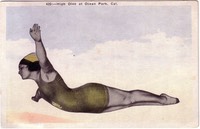David Clark L.A. On Foot: A Free Afternoon, Camaro Publishing: Los Angeles, 1976, 1927, 1926
"Directions: From downtown L.A. take the Santa Monica Freeway west to Lincoln Blvd., then right (west) on Pico Blvd., and left (south) on Neilson Way. Proceed south on Neilson as it changes into Pacific, then turn right (west) on Rose Ave. and park your car. Walk west to Ocean Front." p. 27
"You are now at the site of the mysterious disappearance of Aimee Semple McPherson on May 18, 1926. Sister Aimee is the shining symbol of our city, with all its flamboyance, brashness and Culture of Eccentricity. If Chicago is the Hog Butcher of the Nation, tempting farm boys under the gaslights, then L.A. is its Faith Healer, the City of the Second Chance. Sister Aimee led the way with a brand of religion denounced by traditionalists as "supernatural whoopee." Most Angelenos agreed with Harper's Magazine in 1927 that she provided "the best show in town," and her Angelus Temple in Echo Park, seating five thousand, was a "must" item on the agenda of every tourist.
"Aimee created a charismatic faith to match the new competition of radio and movies. Thompson Eade, a former vaudevillian who told me that he had been miraculously cured of shell shock by Aimee, designed a giant stage on which sermons became panoramas. The stage set might show the destruction of the world in flames and believers crossing over into heaven, or Aimee would chase a band of devils wearing horns and tails (representing her enemies) around the stage with a pitchfork. On one occasion she roared onto the stage on a motorcycle in a traffic cop's uniform, jumped off the cycle and shouted, "Stop in the name of the Lord!" Her message was positive, never dwelling upon divine punishment and retribution. Many Protestant ministers resented her for taking away many of their parishioners, and labelled her services, a "sensous debauch." When Aimee led a crusade in London, these ministers sent a delegation to warn the British of "her tendency to induce insanity in her audiences." p. 28
"Sister Aimee's controversial career hit its peak when she disappeared from Ocean Park Beach, where you now stand, after leaving her room at the Ocean View Hotel, the large white building at the corner of Rose Ave. and Ocean Front Walk. Los Angeles went wild with panic at the news. Thousands, hoping for her return, kept a continuous prayer vigil at the beach. Her mother announced that she had ascended into heaven, to sit among the angels. but on June 23 she suddenly appeared at the Mexican border, with the story that she had been kidnapped by two miscreants named Jake and Mexicali Rose, and had escaped when they were drunk. The largest crowd ever to greet a public figure in L.A. turned out for her return, including the entire Fire Department (which she had converted) and the Mayor and the City Council.
"Skepticism was soon expressed, however, by reporters who noted that her flight across the desert had left her shoes unscuffed and her skin unburned. (I have interviewed one of first men to seee Aimee when she appeared at the border. He stated that she did not seem to have been through a long desert ordeal.) Aimee answered that neither had Shadrach, Meshach and Abednego been touched by the flames of the fiery furnace. The most often-repeated explanation was that she had been in a "love nest" in Carmel with the handsome radio operator of her church, but this was never proven. Recently, Milton Berle, in his autobiography, claimed to have had an affair with her . . . What is far more certain is that she fed over one and one-half million people during the Depression, providing the only aid mission in L.A. where food, clothing and shelter were given with no questions asked and no red tape. Throughout the '20s and '30s, when Christianity was the third largest industry in Los Angeles after the movie industry and real estate, she gave hope and entertainment to many." p.30
